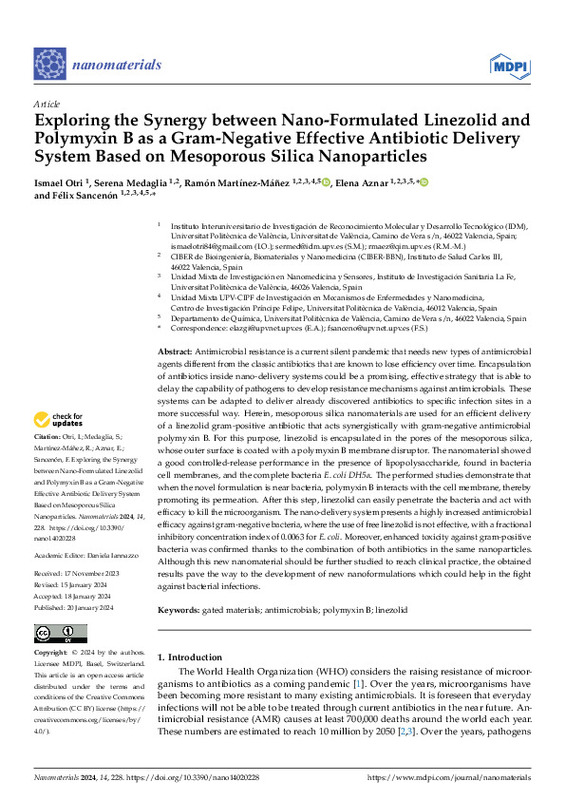JavaScript is disabled for your browser. Some features of this site may not work without it.
Buscar en RiuNet
Listar
Mi cuenta
Estadísticas
Ayuda RiuNet
Admin. UPV
Exploring the Synergy between Nano-Formulated Linezolid and Polymyxin B as a Gram-Negative Effective Antibiotic Delivery System Based on Mesoporous Silica Nanoparticles
Mostrar el registro sencillo del ítem
Ficheros en el ítem
| dc.contributor.author | Otri, Ismael
|
es_ES |
| dc.contributor.author | Medaglia, Serena
|
es_ES |
| dc.contributor.author | Martínez-Máñez, Ramón
|
es_ES |
| dc.contributor.author | Aznar, Elena
|
es_ES |
| dc.contributor.author | Sancenón Galarza, Félix
|
es_ES |
| dc.date.accessioned | 2024-03-04T19:02:54Z | |
| dc.date.available | 2024-03-04T19:02:54Z | |
| dc.date.issued | 2024-01 | es_ES |
| dc.identifier.uri | http://hdl.handle.net/10251/202921 | |
| dc.description.abstract | [EN] Antimicrobial resistance is a current silent pandemic that needs new types of antimicrobial agents different from the classic antibiotics that are known to lose efficiency over time. Encapsulation of antibiotics inside nano-delivery systems could be a promising, effective strategy that is able to delay the capability of pathogens to develop resistance mechanisms against antimicrobials. These systems can be adapted to deliver already discovered antibiotics to specific infection sites in a more successful way. Herein, mesoporous silica nanomaterials are used for an efficient delivery of a linezolid gram-positive antibiotic that acts synergistically with gram-negative antimicrobial polymyxin B. For this purpose, linezolid is encapsulated in the pores of the mesoporous silica, whose outer surface is coated with a polymyxin B membrane disruptor. The nanomaterial showed a good controlled-release performance in the presence of lipopolysaccharide, found in bacteria cell membranes, and the complete bacteria E. coli DH5. The performed studies demonstrate that when the novel formulation is near bacteria, polymyxin B interacts with the cell membrane, thereby promoting its permeation. After this step, linezolid can easily penetrate the bacteria and act with efficacy to kill the microorganism. The nano-delivery system presents a highly increased antimicrobial efficacy against gram-negative bacteria, where the use of free linezolid is not effective, with a fractional inhibitory concentration index of 0.0063 for E. coli. Moreover, enhanced toxicity against gram-positive bacteria was confirmed thanks to the combination of both antibiotics in the same nanoparticles. Although this new nanomaterial should be further studied to reach clinical practice, the obtained results pave the way to the development of new nanoformulations which could help in the fight against bacterial infections. | es_ES |
| dc.description.sponsorship | Please additionally note that this research was supported through project PID2021-126304OB-C41 funded by MCIN/AEI/10.13039/501100011033/ and by the European Regional Development Fund A Way of Doing Europe. This study also forms part of the Advanced Materials Programme (MFA/2022/053) and was supported by MCIN with funding from the European Union NextGenerationEU (PRTR-C17.I1) and by Generalitat Valenciana. This study was also supported by Generalitat Valenciana (CIPROM/2021/007). I.O. was funded by the Erasmus Mundus Programme, Action 2, Lot 1, Syria (predoctoral fellowship). S.M. was funded by Generalitat Valenciana (Santiago Grisolía fellowship). | es_ES |
| dc.language | Inglés | es_ES |
| dc.publisher | MDPI AG | es_ES |
| dc.relation.ispartof | Nanomaterials | es_ES |
| dc.rights | Reconocimiento (by) | es_ES |
| dc.subject | Gated materials | es_ES |
| dc.subject | Antimicrobials | es_ES |
| dc.subject | Polymyxin B | es_ES |
| dc.subject | Linezolid | es_ES |
| dc.subject.classification | QUIMICA ORGANICA | es_ES |
| dc.subject.classification | QUIMICA INORGANICA | es_ES |
| dc.title | Exploring the Synergy between Nano-Formulated Linezolid and Polymyxin B as a Gram-Negative Effective Antibiotic Delivery System Based on Mesoporous Silica Nanoparticles | es_ES |
| dc.type | Artículo | es_ES |
| dc.identifier.doi | 10.3390/nano14020228 | es_ES |
| dc.relation.projectID | info:eu-repo/grantAgreement/AEI/Plan Estatal de Investigación Científica y Técnica y de Innovación 2021-2023/PID2021-126304OB-C41/ES/NUEVOS MATERIALES Y SONDAS PARA EL RECONOCIMIENTO, LIBERACION DE FARMACOS, NANOMOTORES Y COMUNICACION/ | es_ES |
| dc.relation.projectID | info:eu-repo/grantAgreement/GVA//MFA%2F2022%2F053/ | es_ES |
| dc.relation.projectID | info:eu-repo/grantAgreement/GVA//CIPROM%2F2021%2F007/ | es_ES |
| dc.relation.projectID | info:eu-repo/grantAgreement/MICINN//PRTR-C17.I1/ | es_ES |
| dc.rights.accessRights | Abierto | es_ES |
| dc.contributor.affiliation | Universitat Politècnica de València. Escuela Técnica Superior de Ingenieros Industriales - Escola Tècnica Superior d'Enginyers Industrials | es_ES |
| dc.contributor.affiliation | Universitat Politècnica de València. Escuela Técnica Superior de Ingeniería del Diseño - Escola Tècnica Superior d'Enginyeria del Disseny | es_ES |
| dc.description.bibliographicCitation | Otri, I.; Medaglia, S.; Martínez-Máñez, R.; Aznar, E.; Sancenón Galarza, F. (2024). Exploring the Synergy between Nano-Formulated Linezolid and Polymyxin B as a Gram-Negative Effective Antibiotic Delivery System Based on Mesoporous Silica Nanoparticles. Nanomaterials. 14(2). https://doi.org/10.3390/nano14020228 | es_ES |
| dc.description.accrualMethod | S | es_ES |
| dc.relation.publisherversion | https://doi.org/10.3390/nano14020228 | es_ES |
| dc.type.version | info:eu-repo/semantics/publishedVersion | es_ES |
| dc.description.volume | 14 | es_ES |
| dc.description.issue | 2 | es_ES |
| dc.identifier.eissn | 2079-4991 | es_ES |
| dc.identifier.pmid | 38276746 | es_ES |
| dc.identifier.pmcid | PMC10818268 | es_ES |
| dc.relation.pasarela | S\509646 | es_ES |
| dc.contributor.funder | Generalitat Valenciana | es_ES |
| dc.contributor.funder | Agencia Estatal de Investigación | es_ES |
| dc.contributor.funder | European Regional Development Fund | es_ES |
| dc.contributor.funder | Ministerio de Ciencia e Innovación | es_ES |








